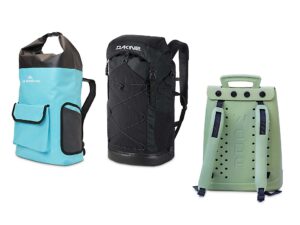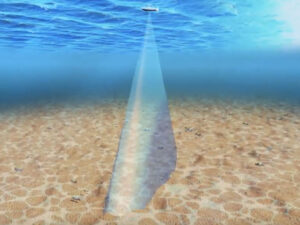Did you ever have a fuel gauge that was accurate? Same here. They either read full for days, then take a nose dive to a quarter tank, or wander about the dial hoping to be right at least some of the time. Either way, it’s dangerous when you don’t know if there’s enough fuel to get home. So we decided to look into the causes for inaccuracies in fuel-monitoring systems. Is it the senders, the gauges, or something else?
Tanks
To conduct our test, we got a stock rotomolded polyethylene permanent-mount belly tank from Moeller Marine Products, one of the country’s largest suppliers of OEM and aftermarket fuel tanks. It’s a typical 36-gallon model that you might find in a stern drive or outboard boat-rectangular on top, coming to a shallow V at the bottom. The first thing that became obvious was that “empty” is a relative concept. A typical pickup fitting is suspended about 1″ over the bottom of the tank. The senders, no matter which type, are usually in line with that fitting. That means a tank will always have a small amount of fuel that can’t be accessed. This is done so the gunk that settles to the bottom doesn’t get sucked into the engine. Depending on the size of the tank, there could be quite a few gallons that can’t be used. A rectangular tank lets you easily figure how much is left. If the tank is 10″ deep, that unused 1″ is 10 percent of the capacity. When the tank’s shape is odd, so are the computations for full and empty. Because the bottom of a belly tank is V-shaped, the inaccessible fuel is less than that in a rectangular one of the same capacity. This V-shape gives your engine access to more fuel, but if the sender or gauge hasn’t been configured for an irregular-shaped tank, the readings will be off.
Gauges
We looked at ones with analog readouts by Faria, Isspro, Teleflex, and Wema. We tested these gauges against a simple swing arm sender made by Teleflex, the most common type and the one that probably came with your tank. We filled the tank with 4 gallons (effectively empty), 9 gallons (quarter tank), 18 gallons (half tank), and filled to the top. Here’s what we found. At full, all gauges read full. At empty the readings ranged from empty to a little less than ¼. The ¼ readings were from ¼ to slightly over. The ½ readings were from ½ to less than a ¼. None of the gauges consistently measured the correct amounts.
Senders
We tested three different types of senders: column, float, and ultrasonic. We used the Wema, Faria, and Isspro column type, the Teleflex floating arm, and an ultrasonic unit from SSI that bounces sound waves off the top of the fuel. We tested them paired with the Wema gauge (on average the most accurate) and the Teleflex gauge (the most common). The three column senders and the SSI ultrasonic were matched by their manufacturers to correspond with the Moeller tank’s dimensions. We cut and fit the Teleflex according to its installation instructions. Of all the senders, the SSI ultrasonic was the most accurate and consistent, regardless of the gauge, throughout the four levels. The column senders were about equal, with the Isspro having a slight edge. The floating arm Teleflex was the least accurate.
The Bad News
Our testing was done on a stable platform that wasn’t subject to bow rise or internal turbulence caused by typical operating conditions. Even under ideal conditions, we confirmed our original assumption: Fuel gauges and senders in marine applications are unreliable. Put them on a moving boat, and you have more trouble. One bright note: The SSI ultrasonic sender, when properly matched to the tank, gave the best results.
The Good News
All is not lost, however. The old, reliable, low-tech dipstick will never let you down. To accommodate the stick, remove the existing sender and use Moeller’s standard five-hole blank plate to cover the sender hole. It should be drilled and tapped to accept a 1½” OD nipple. Next, drill a hole in the deck directly above the old sender hole and install a standard gas-fill deck fitting. Connect this to the new tank fitting with 1½” fuel hose. For accuracy, sounding the tank with a stick is best done while the boat isn’t underway. The stick itself can be divided into eighths or quarters and shouldn’t be painted or coated because the wet reading is easier to see on dry, unfinished wood. If you’re stuck with a gauge, bulletproof the electrical connections. Float senders take their measurement by creating resistance. Check yours with a meter on the two connectors. Senders generally operate between about 30 ohms (full) and 240 ohms (empty). All connectors should be protected by heat-shrinking and coated with a dielectric silicone grease (available at Radio Shack). Every second season take the sender out and see if it moves smoothly and isn’t gummed up.
An Accurate Alternative
****Rather than rely on senders and gauges, you can use a flow meter to measure real-time and cumulative fuel consumption. We installed a FloScan Model 9000 and, after a bit of calibration, found that the digital reading of the gallons consumed over a measured 30-mile course was accurate to within 1 percent of actual usage. In addition, with the 9000 communicating with our GPS, we received critical gph and mpg information that allowed us to find the best rpm and trim tab positions for the most efficiency. The cumulative (and resettable) gallons consumed reading does away with the need for senders and gauges, although it’s good to keep them as backup. The FloScan gives direct readings, using a turbine to measure the actual passage of fuel. This is the most accurate method. Not far off is what you’ll find if you have a Mercury SmartCraft or similar system. Most of these take their readings from the engine’s computer, with the consumption calculations based on theoretical flow through the injectors. If an injector is fouled, or there are other issues, the calculations continue as if nothing is wrong and can give false data. Both direct and indirect reading monitoring systems are more accurate than a conventional sender/gauge system. Either way, use the old 1⁄3 tank out, 1⁄3 back, 1⁄3 just-in-case rule, and be aware of intermediate ports along the way that sell fuel. Most of all, keep your towing insurance paid up-no system is perfect.









